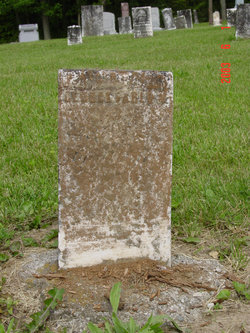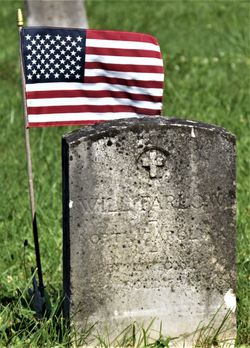| Description |
: |
Born about 1708, died about 1775 from a rattlesnake bite.
IMPORTANT: Michael and wife Mary are NOT buried at Marlboro Friends Cemetery, but a monument to them and their descendants was erected over the graves of their son Nathan and his wife Ruth in 1948. The likely location of their and his father John Farlow's unmarked graves is mentioned below. Also, it is not known where Michael and wife Mary were born--some sources and traditions maintain that they were both born in Ireland and came to America in the same ship as children, while others assert he was descended...
Read More
|
Born about 1708, died about 1775 from a rattlesnake bite.
IMPORTANT: Michael and wife Mary are NOT buried at Marlboro Friends Cemetery, but a monument to them and their descendants was erected over the graves of their son Nathan and his wife Ruth in 1948. The likely location of their and his father John Farlow's unmarked graves is mentioned below. Also, it is not known where Michael and wife Mary were born--some sources and traditions maintain that they were both born in Ireland and came to America in the same ship as children, while others assert he was descended from the Farleys-Farlows of Virginia who were early settlers near Jamestown. At any rate, they were in Pennsylvania before 23 November 1738, when they were married in Holy Trinity AKA Old Swedes Church, Wilmington, New Castle Co., DE, and his father came with them to present-day Randolph Co., NC before 1758.
The following is quoted from a note written by a descendant, Nathan Farlow, in 1887, a transcription of which is in the Asheboro, NC, Public Library's Genealogy Room in the Farlow Files:
Copy of The Ancestry of Nathan Farlow, Written by Himself
3rd Mo. 29-1887
I have had it in view for some time to write a short sketch of my Ancestors, so far as memory and tradition will enable me to do so. My great grandfather's name was Michael Farlow, an Irishman by birth; his wife's maiden name I never knew, more than her given name was Nancy. I have understood that they both came from Ireland in the same vessel when they were children, and landed in Pennsylvania where I suppose they were married. They removed to North Carolina and at the time of his death, which was caused by the bite of a rattlesnake, lived in Randolph County, a few miles north of Asheboro. They had three sons and several daughters, but I cannot tell their number nor their names. The names of their sons were Nathan, William and George. The last two named removed to Indiana soon after the country was settled. I understand that their descendants are quite numerous over Indiana and perhaps other western states. Nathan, my grandfather, married Ruth Carter, daughter of Nathaniel and Ann Carter, and had eleven children, six sons and five daughters. Their sons names were Isaac, George, Joseph, Enoch, Michael and Nathan. Their daughters names were Nancy, Mary, Ruth, Elizabeth and Hannah. My grandfather removed from Chester County, Pennsylvania and lived in the neighborhood of New Market, Randolph County, near Marlboro Meeting of which he was a member, and for a number of years the head of that Meeting. I never understood that his brothers, William and George, belonged to any organization except Free Masons.
My grandfather on my Mother's side was William Newby, a descendant of a wealthy family in Perquimans County, N.C. He married Elizabeth Ratliff, said to be a woman of considerable refinement. They removed from Perquimans County and resided near Back Creek Meeting house in Randolph County. They had a family of twelve children, six sons and six daughters. The names of their sons were Joshua, Frederick, Gabriel, Samuel, William and Josiah. The names of their daughters were Nancy, Sarah, Elizabeth, Miriam, Mary and Jemima. My grandmother Newby died before my remembrance. My grandfather, after he had settled most of his children around him, married in his old age, a widow Small by whom he had three sons, Thomas, Cyrus, and Joseph. When they were children he removed (old as he was) to Wayne County, Indiana, where he died. These three sons, I understand, were mostly respectable and wealthy men. Some of them are yet living, not [now?] very old men. My Father's name was George, second son of my grandfather, Nathan Farlow. He married Sarah Newby, my Mother, I think about the year 1790, and had a family of eleven children, six sons and five daughters. The names of their sons were Isaac, Nathan, Zimri, Michael, Newby, and Jonathan. Their daughters, Mary, Elizabeth, Rebecca, Nancy and Ruth. At this date but three of the eleven are living. My Mother died in 1830 being about 53 years old. My Father died in 1850, being near 80 years old.
*********************************************************
The following information about Nathan and Ruth Carter Farlow and their parents is taken from a letter written by their grandson, Nathan F. Spencer (1817-1903), before 1860, and reproduced in E. Edgar Farlow's "A Brief History of the Farlow Family 1623-1953":
"My Grandmother, Ruth Carter Farlow, came to Carolina in company with others from Chester County, Pennsylvania. She was then a very beautiful girl, highly respected by her friends and acquaintances, and I have heard my mother often tell that when her mother was ready to depart the people of the town would have it to be public by her ringing the town bell, which she did. So great was the affection and esteem of her friends and acquaintances that it was a very solemn parting. Many tendered their good wishes and desired that they might have a safe and prosperous journey to her prospective home in North Carolina. Thus it was with the benediction of the people among whom she had lived and associated.
With her little company and with horses and wagons they took their departure. Much of the way to be passed through then was a wilderness country. Large rivers were to be ferried over, deep creeks to be forded, and almost impassable bogs and hills and mountains to overcome.
I have heard my mother tell about grandmother fording the Brandywine. The ford was deep and she rode on a horse behind 'Indian Bill', and he would say to her, 'Hold tight, Ruthy.'
Now, I know nothing further about grandmother going to North Carolina, and to Orange County except that later a strip of land 39 by 60 was cut off from Orange County and later divided into Guilford and Randolph Counties. Now, whether grandmother before her marriage with grandfather lived on what was left of Orange or in the new county of Randolph, I do not know. I do know when I first became acquainted with them. They were quite old and lived about half a miles south of Marlboro Meeting House. I saw them often, my dear parents taking me with them to see them. When they departed this life their remains were laid side by side in the Marlboro grave yard. I was present when they were buried.
Now I might remark before I proceed further, that my great grandfather, Michael Farlow, came with his family and perhaps others, from Pennsylvania to Carolina and located on a piece of land in what is now Randolph County, about six miles from where my grandfather afterwards settled. I have often passed along the public road to the county seat and have seen some parts of his house still standing. It is all gone now. The road ran within a few yards of the house. A railroad now runs near by. There is the spring near at hand where they got their water. I have many times quenched my thirst at the same fountain when I was passing. There too is a little plot of ground that shows where his barn stood, at which, while cutting briers and weeds with a hoe, he was bitten by a rattlesnake. It was at the time of gathering in of the wheat harvest. One of his sons, coming up with a load of wheat, he said, 'Bill, here is a snake and it has bit me.' He was soon in great misery. My grandparents were sent for and went immediately to him and found him in great pain and agony. Grandmother said to him, 'Is thy misery great?' 'Oh!' he said 'It is as if it were burning in the fire!' I don't know what time in the day he was bitten but he died during the night and was buried one hundred yards north of the house. I think from what I have heard of him he was about common level of man in real worth and ability, neat and clean in his appearance. I have heard my mother say he wore silk stockings and slipper shoes in warm weather, and such he was wearing when bitten by the snake. With this digression I will now return to the narrative account of my grandparents.
By what ceremony they were married I cannot certainly say, but it might be reasonably supposed that such strict Friends as they were would use endeavors to accomplish it by Friends' ceremony. Be that as it may, it appears they lived together in harmony and unity for many years, and raised a large family, six sons and five daughters, all of whom married and settled on farms near by and in neighborhoods not far distant, except Ruth, who never married. All these had children, but Ruth preferred to stay at home and with her aged parents in their declining years, and take care of them as long as they lived.
The names of their children and whom they married are as follows: Nancie married Jabe Davis, Isaac married Mary Holliday, Enoch married Lydia Montgomery, Joseph married Ruth Lindley, Michael married Hannah Newlin, Mary married Isaac Spencer, Ruth never married, Elizabeth married John Spencer, Nathan married Peggie Spencer, Hannah married William Andrews.
Grandmother was a woman of good understanding and commanding appearance, and withal a pious christian. In the time of the Revolutionary War the British soldiers were encamped within about a mile of her house, and would go there to get what they could. On one occasion there came a squad of them into the yard, and some of them broke into the smoke house and cursed their eyes if there was not plenty of bacon there. Grandmother went out among them and said to the one in command, 'Does thee allow thy boys to do that way?' He said, 'Shut up that door.' Some of them came into the house to see what was there. One snatched a quilt off the bed and another said, 'You have lost your quilt, Madam.' She replied, 'No, he will bring it back in the morning.' Sure enough, he came in and said, 'Here is your rug, Madam. It was very cold, very cold last night. Will you give me a washing of soap?' 'Yes I will,' was the reply. On another occasion she sent their little boy Isaac, who was about ten years old, after their cattle which grazed in the range. He rode a very fine mare and it so happened that soldiers met up with the lad and took the mare from him. He went home crying. The next day grandmother went to the British encampment and to the chief commander and related to him how her little boy had been served the evening before by his soldiers, how they had taken her mare from him, and that she had come to tell him and to demand her mare. He said, 'Madam, you shall have your mare.' He ordered a search to be made for her, and she was found and returned to her. I have often heard my Grandmother tell this story."
The following are statements made by Nathan Spencer about Nathan and Ruth Farlow, his grandparents.
"I will first say a few words about grandfather and grandmother. Grandfather was quite a young man when he came to Carolina. What his occupation was before marriage with Ruth Carter I do not know, but after his marriage he followed farming, taught school, built wagons, and made hollow ware to sell. He was called a good liver. He was a religious man, of a grave countenance, and his presence always commanded respect. He was a true Friend. He was an Elder in the church and sat at the head of the Meeting as long as he was able to go. He died in his ninety-first year and was laid in the Marlboro grave yard about sixty-nine or seventy years ago. No record of his death or birth appear. On his headstone is inscribed simply Nathan Farlow.
George and Nathan Farlow must have been brothers, and Isaac the son of Nathan, for Isaac says his Uncle George Farlow, who was then living in a cabin on the roadside with a small lot enclosed around it,---the house stood on the east bank of Weebs Creek about three or four miles east of Asheboro. Isaac Farlow was more than 87 years old when he died. Rev. E.W. Carothers, D.D. says that in 1854 Isaac was then 87 years old. So Isaac was born in 1767, and was 15 years old when his father Nathan and mother, Ruth, dressed Capt. John Bryant, who was killed by Fanning. Bryant lived a half mile west of New Market, on the place owned by Joseph Newling (sic).
Nathan Spencer says, "My informant had to pay a fat steer and some gold for his land, but in process of time Nathan Farlow owned all the land of these men who were Tories, and he himself, Isaac Farlow, now lives on the low land.
When Richard Isaacs went over and told Nathan Farlow what had happened, he and his wife, Ruth, went over to the Bryants before daylight, but Nathan stopped at some distance from the house until he ascertained whether he could go with safety. By daylight Nathan Farlow and his wife had the corpse laid out. At sunrise Isaac Farlow went over and saw the body and the two bullet holes.
It seems what Isaac Farlow says was taken for the truth, as they went to him for facts. Isaac, a respectable member of the Quaker Society, who is now an old man, but seems to retain all his faculties unimpaired. He lived in Deep River, the neighborhood where many of the atrocities were committed, and well recollects all that he saw or heard. From his statement I have been able to trace sequence of events better than any previous account I have received, and he gives some additional facts of considerable interest. To converse with such a man is like being carried back to those days, and sit down midst the very scenes of desolation and wretchedness as they actually existed."
Nathan F. Spencer's wife, Mary Newlin, daughter of Joseph and Ruth Farlow Newlin, was his first cousin once removed.
*********************************************************
Notes on his probable burial location, from the "Farlow Family History CD" by Betsy C. Farlow, Ph.D. and Charles H. Farlow:
On 12 June 2003, Kermit Farlow took Betsy, Charles and Binford Farlow to the location of the graves
of John Farlow, his son Michael, and daughter-in-law Mary. The site is within two miles of Marlboro
Friends Meeting. Kermit believes they were buried on the present W. S. Beeson farm on Beeson Farm
Road. He recalls that "Whistling Ike" and Delphiny Farlow, children of Samuel Farlow (son of Isaac,
grandson of Nathan) took care of three graves on their farm until they died and the farm was sold.
***************************************
From "Farlow Family History" (2008) by Betsy C. Farlow, Ph.D. and Charles Hunt Farlow:
There are two theories about the first Farlow emigrant to America. One suggests that it was a Thomas Farlow, who arrived in Jamestown, Virginia in 1623 with his wife, Jane, a child, and a Welsh servant, Nicholas Shotten. They settled in Archer's Hope. Thomas served twice in the Virginia House of Burgesses. He is listed once as Thomas Farlowe and once as Thomas Farley. Many members of the Farley family claim him as their ancestor. However, there is no evidence that descendants of Thomas are ancestors of later Farlows. Enoch Edgar Farlow hypothesized that, according to some naming patterns, Thomas had a son John and a grandson Thomas. In turn, the John who is No. 1 in this book was the great-grandson of Thomas of Jamestown. Edgar Farlow had this information carved on a monument in the cemetery at Marlboro Friends Meeting in Randolph County, North Carolina. However, this remains only a theory and has not been proved. The second theory holds that John Farlow emigrated from Ireland early in the 18th century with his wife and some children. Other children were born after his arrival. Other families closely associated with the Farlows also came from Ireland, particularly the Carters and Harlans. The Farlow surname is found in Irish records. One John Farlow of Ireland is sometimes referred to as Capt. John Farlow, an officer in the army of Oliver Cromwell. Another Capt. Farlow died in the battle of Limerick in 1691. Neither of these is likely the John Farlow who emigrated to Pennsylvania.
In John O'Hart, IRISH LANDED GENTRY WHEN CROMWELL CAME TO IRELAND, New
York, 1873 are found the names Martin Farley, Josias Farloe, Martin Farlow, Capt. Josias Farlowe and Martin Farly. They are members of "The 'Forty Nine' Officers." Their nationality is not known. The surname FARLOW is infrequently found in Ireland today, but it is present in several counties.
A deed exists, showing the purchase of land by John Farillow from James Morpheus and wife in St. Luke township, Rowan County, NC, date 31 (sic) April 1758. The citation reads Rowan County Record of Deeds, C.085.40003, Vol. 6, p. 284--Morpheus to Farlow c. 1766. The document itself gives the earlier date, as will be seen in this transcription: This Indenture made the Thirty first Day of April in the year of our Lord 1758 Between James Morpheus & Mary his wife of Rowan County in the province of North Carolina, planter of the one part, and John Farillow of the sd province, Wheelwright,
of the other part. WITNESSETH that the said James Morpheus & Mary his wife for & in
Consideration of the sum of Five Shillings Sterling money to them in hand paid by the sd John Farillow at or before the Sealing & Delivery of these presents, the Receipt whereof is hereby acknowledged, Hath granted Bargained & Sold & by these presents doth Grant Bargain & Sell unto the sd John Farillow one Certain Tract Piece or parcel of Same Lying and being in the parish of St. Luke in the county & province afds. Beginning at a Hickory on William McQwin's west Line Running from thence N. 46 chains to a steak thence West to Wm Buis East corner Tree of his survey where he lives then South 22 Chs to William Buis Beginning Tree then South 30 Degrs West 18 Chs then along the division line East 39 Chs to the first Station containing in the whole Two Hundred and
Ninety seven acres of Land (being part of a Tract of Five hundred and eighty one acres Granted by the right Honble John Earl Granville to the sd James Morpheus as appears by a Deed of Sale of Record Bearing Date November the Sixth 1756) and all Houses Buildings orchards Gardens Improvements Ways Waters watercourses profits commodities Hereditaments & Appurtenances whatsoever to the sd premises hereby granted and the Reversion & Reversions Remainder & Remainders Parts Rents &
profits thereof TO HAVE AND TO HOLD the sd Two hundred & ninety seven acres of Land
Hereditaments & premises as above Butted and Bounded be the same more or less and all & Singular other than? premises hereby Granted with these & Every of their Appurtenances Parts Members Tenemens? & Advantages unto the sd John Farillow his Heirs & Assignees from the Day before the Date thereof for & During the full Term & time of one whole year from then next Ensuring? to be compleat & Ended yielding & paying therefore the Rent of one pepper-corn on Lady Day next only if the same be then Demanded To the Intent & purpose that by virtue of these presents and by force of
the Statute for Transferring also into possession the sd John Farillow may be in actual possession of the premises & be Enabled to accept & take a Spread? & Release of the Reversion & Inheritance thereof to him & his Heirs and Assigns for Ever.
In Witness whereof the sd James Morpheus & Mary his wife Hath hereunto set their hands & affixed their Seals the Day & year first above written.
Signed Sealed & Delivered } David Jones James Morpheus {seal}
In the presence of } William Buis Mary Morpheus {seal}
(Lady Day--According to Black's Law Dictionary: Laghday, or lahdy, lage day--a day of the county court.)
"On March 13, 1753, a petition bearing the signatures of 348 of the inhabitants of the upper and frontier portions of Anson County was read in the lower house of the Colonial Assembly. The petitioners noted the great hardship they had to undergo in traveling the vast distance to the courthouse in Anson and requested that a new county be designated. On April 4 a bill was introduced for "erecting a County, and Parish, on the Head of Anson County." Both houses of the Assembly passed the bill and on April 12 [1753] the acting governor, Matthew Rowan, signed it into law, thus creating
Rowan County and St. Luke's Parish." (James S. Brawley. ROWAN COUNTY: A BRIEF
HISTORY, revised. Raleigh: N. C. Dept. of Cultural Resources, 1977, p. 4-5.) |



